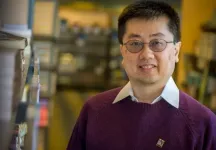(Press-News.org) A study published in Science Advances reports on the unexpected observation of thermal waves in germanium, a semiconductor material, for the first time. This phenomenon may allow a significant improvement in the performance of our electronic devices in a near future. The study is led by researchers from the Institute of Materials Science of Barcelona (ICMAB, CSIC) in collaboration with researchers from the Universitat Autònoma de Barcelona, and the University of Cagliari.
Heat, as we know it, originates from the vibration of atoms, and transfers by diffusion at ambient temperatures. Unfortunately, it is rather difficult to control, and leads to simple and inefficient strategies to manipulate it. This is why, for example, large amounts of residual heat can accumulate in our computers, mobile phones and, in general, most electronic devices.
However, if heat was transported through waves, such as light, it would offer new alternatives to control it, especially through the unique and intrinsic properties of waves.
Thermal waves have been observed to date only in few materials, such as solid helium or, more recently, in graphite. Now, the study published in Science Advances by researchers from the Institute of Materials Science of Barcelona (ICMAB, CSIC) in collaboration with researchers from the Universitat Autònoma de Barcelona, and the University of Cagliari, reports on the observation of thermal waves on solid germanium, a semiconductor material used typically in electronics, similar to silicon, and at room temperature. "It was not expected to encounter these wave-like effects, known as second sound, on this type of material, and in these conditions," says Sebastián Reparaz, ICMAB Researcher at the Nanostructured Materials for Optoelectronics and Energy Harvesting (NANOPTO) Group and leader of this study.
The observation occurred when studying the thermal response of a germanium sample under the effect of lasers, producing a high-frequency oscillating heating wave on its surface. The experiments showed that, contrarily to what was believed until now, heat did not dissipate by diffusion, but it propagated into the material through thermal waves.
Apart from the observation itself, in the study, researchers unveil the approach to unlock the observation of thermal waves, possibly in any material system.
What is second sound and how can it be observed in any material
First observed in the 1960s on solid helium, thermal transport through waves, known as second sound, has been a recurrent subject for researchers who have repeatedly tried to demonstrate its existence in other materials. Recent successful demonstrations of this phenomenon on graphite have revitalized its experimental study.
"Second sound is the thermal regime where heat can propagate in the form of thermal waves, instead of the frequently observed diffusive regime. This type of wave-like thermal transport has many of the advantages offered by waves, including interference and diffraction", says ICMAB researcher Sebastián Reparaz.
"Wave-like effects can be unlocked by driving the system in a rapidly varying temperature field. In other words, a rapidly varying temperature field forces the propagation of heat in the wave-like regime" explains Reparaz, and adds, "The interesting conclusion of our work is that these wave-like effects could be potentially observed by most materials at a sufficiently large modulation frequency of the temperature field. And, what is even more interesting, its observation is not restricted to some specific materials."
Applications of second sound in a near future
"The possible applications of second sound are limitless", says Sebastián Reparaz. Achieving these applications, however, will require a deep understanding on the ways to unlock this thermal propagation regime on any given material. Being able to control heat propagation through the properties of waves opens new ways to design the upcoming generations of thermal devices, in a similar way to the already established developments for light. "Specifically, the second sound thermal regime could be used to rethink how we deal with waste heat", he adds.
From a theoretical point of view, "these findings allow unifying the current theoretical model, which until now considered that materials where this type of wave-like behavior was observed (such as graphite) were very different from the semiconductor materials currently used in the manufacture of electronic chips (such as silicon and germanium)" says F. Xavier Álvarez, researcher at the UAB. "Now all these materials can be described using the same equations. This observation establishes a new theoretical framework that may allow in the not too distant future a significant improvement in the performance of our electronic devices," adds Álvarez.
INFORMATION:
Cambridge scientists have identified 200 approved drugs predicted to work against COVID-19 - of which only 40 are currently being tested in COVID-19 clinical trials.
In a study published today in Science Advances, a team led by researchers at the University of Cambridge's Milner Therapeutics Institute and Gurdon Institute used a combination of computational biology and machine learning to create a comprehensive map of proteins that are involved in SARS-CoV-2 infection - from proteins that help the virus break into the host cell to those generated as a consequence of infection. By examining this network using artificial intelligence (AI) approaches, ...
Language distinguishes us humans; we learn it through experience and social interactions. Especially in the first year of life, human vocalizations change dramatically, becoming more and more language-like. In our closest relatives, non-human primates, language development was previously thought to be largely predetermined and completed within the first few weeks after birth. In a behavioral study now published, researchers from the German Primate Center, the University of Tübingen and the Rockefeller University New York were able to show that the infantile development of vocalizations in common marmosets also includes an extended flexible phase, without ...
Researchers from Baidu Research Robotics and Auto-Driving Lab (RAL) and the University of Maryland, College Park, have introduced an autonomous excavator system (AES) that can perform material loading tasks for a long duration without any human intervention while offering performance closely equivalent to that of an experienced human operator.
AES is among the world's first uncrewed excavation systems to have been deployed in real-world scenarios and continuously operating for over 24 hours, bringing about industry-leading benefits in terms of enhanced safety and productivity.
The researchers described their methodology in a research paper published ...
Researchers studying the intersection of politics and psychology have long documented a link between threat sensitivity and social conservatism: People who are more socially conservative tend to react more strongly to threats. Conversely, those who are more socially liberal tend to be less sensitive to threats, viewing the world as a generally safe place and embracing change to explore new possibilities.
These findings have held across a variety of events, but during the pandemic, U.S. polls show that Democrats, who tend to be more liberal, have generally been more concerned about the COVID-19 threat than ...
URBANA, Ill. - Proteins have been quietly taking over our lives since the COVID-19 pandemic began. We've been living at the whim of the virus's so-called "spike" protein, which has mutated dozens of times to create increasingly deadly variants. But the truth is, we have always been ruled by proteins. At the cellular level, they're responsible for pretty much everything.
Proteins are so fundamental that DNA - the genetic material that makes each of us unique - is essentially just a long sequence of protein blueprints. That's true for animals, plants, ...
In cases of breast cancer, bone metastasis - when cancer cells spread to new sites in the bone - causes the most breast cancer-related harm and is often incurable in advanced disease. A new study by University of Arizona Health Sciences researchers found that cancer cells become more aggressive when exposed to tissue stiffening and that these changes persist over time.
Tumor stiffening, which develops as diseased breast tissue becomes fibrotic, plays a major role in how breast cancer cells spread throughout the body. The paper, "Breast tumor stiffness instructs bone metastasis via maintenance of mechanical conditioning," published today in the journal Cell Reports, ...
A pair of College of Business professors and their doctoral student at The University of Texas at Arlington are exploring how ransomware attacks sometimes pit organizations against the law enforcement agencies trying to protect them.
Kay-Yut Chen, Jingguo Wang and Yan Lang are authors of a new study in the journal Management Science titled "Coping with Digital Extortion: An Experimental Study on Benefit Appeals and Normative Appeals." Chen and Wang are professors of information systems and operations management at UTA. Lang is a doctoral student in the department.
A ransomware attack is like a cyber hijacking, with criminals infiltrating and seizing an organization's data or computer systems and ...
In hospitals, we know that the nurses are the first to deal with patients in pain. For any ailment, including patients needing hemodialysis, the knowledge of pain management, the nurses have, allow them to provide optimal pain management.
This qualitative study aims to explore the experiences, perceptions, and beliefs of nurses serving in the hemodialysis unit in terms of pain management practices. The study helped identify the educational needs of the nurses to improve pain management in practice. A subjective sample of 16 nurses working in four out-patient hemodialysis units in Amman, Jordan, was hired for this research. Using semi-structured interviews, the data was collected.
The study found five themes and fifteen subcategories ...
Oak Brook, IL - The July edition of SLAS Discovery is a Special Edition featuring the cover article, "Development of a High-Throughput Screening Assay to Identify Inhibitors of the SARS-CoV-2 Guanine-N7-Methyltransferase Using RapidFire Mass Spectrometry" by Lesley-Anne Pearson, Charlotte J. Green, Ph.D., De Lin, Ph.D., Alain-Pierre Petit, Ph.D., David W. Gray, Ph.D., Victoria H. Cowling, Ph.D., and Euan A. F. Fordyce, Ph.D., (Drug Discovery Unit, School of Life Sciences, University of Dundee, Dundee, UK).
In January 2021, a survey of immunologists, infectious-disease researchers and virologists found that 90% of respondents believe SARS-CoV-2 will become endemic, continuing to circulate in pockets of the global population for years to come. Even as vaccines are ...
Boulder, Colo., USA: GSA's dynamic online journal, Geosphere, posts articles online regularly. Locations and topics studied this month include the central Appalachian Mountains; fossil pollen in Colombia; the precision and accuracy of model analyses; the Bone Spring Formation, Permian Basin, west Texas; and the geochronology of modern river sediment in south-central Alaska. You can find these articles at https://geosphere.geoscienceworld.org/content/early/recent .
Spatially variable syn- and post-Alleghanian exhumation of the central Appalachian Mountains from zircon (U-Th)/He thermochronology
Luke C. Basler; Jaclyn S. Baughman; Michelle L. Fame; Peter J. Haproff
Abstract: To assess spatial and temporal patterns of Phanerozoic orogenic burial and subsequent ...

